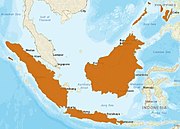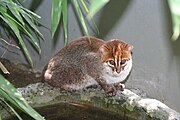Prionailurus
| Prionailurus[1] | |
|---|---|

| |
| Prionailurus species from top-left clockwise: Leopard cat (P. bengalensis), Sunda leopard cat (P. javanensis), flat-headed cat (P. planiceps), fishing cat (P. viverrinus) | |
| Scientific classification | |
| Domain: | Eukaryota |
| Kingdom: | Animalia |
| Phylum: | Chordata |
| Class: | Mammalia |
| Order: | Carnivora |
| Suborder: | Feliformia |
| Family: | Felidae |
| Subfamily: | Felinae |
| Genus: | Prionailurus Severtzov , 1858
|
| Type species | |
| Felis pardachrous Brian Houghton Hodgson, 1844 (= Felis bengalensis Kerr, 1792)
| |
| Species | |
|
See text | |

| |
| Prionailurus ranges | |
Prionailurus is a genus of spotted, small wild cats native to Asia.[2][3] Forests are their preferred habitat; they feed on small mammals, reptiles and birds, and occasionally aquatic wildlife.[4]
Taxonomy
Prionailurus was first proposed by the Russian explorer and naturalist
The British zoologist
Pocock's classification of Prionailurus has been widely accepted, with five species now recognised:[6]
| Common name | Scientific name and subspecies | Range | Size and ecology | IUCN status and estimated population |
|---|---|---|---|---|
| Leopard cat | Prionailurus bengalensis[7] (Kerr, 1792) Two subspecies
|
continental South, Southeast and East Asia.
|
Size: Habitat: Diet: |
LC
|
| Sunda leopard cat | , 1816)
Two subspecies
|
Sundaland islands of Java, Bali, Borneo, Sumatra and the Philippines
|
Size: Habitat: Diet: |
|
| Flat-headed cat | Prionailurus planiceps[9] (Vigors & Horsfield, 1827) |
Thai-Malay Peninsula, Borneo and Sumatra.
|
Size: Habitat: Diet: |
EN
|
| Fishing cat | , 1833) | South and Southeast Asia
|
Size: Habitat: Diet: |
VU
|
| Rusty-spotted cat | , 1834) | Nepal, India and Sri Lanka
|
Size: Habitat: Diet: |
NT
|
Molecular analysis of leopard cat populations indicates a clear distinction between northern populations from Tsushima, Korea, Siberia, China and Taiwan and Southeast Asian populations. If these genetic differences indicate a specific distinction, P. b. euptilurus may yet be a valid species.[12]
The Iriomote cat (P. bengalensis iriomotensis) has been proposed as a distinct species based on morphology, but is considered a subspecies of P. bengalensis based on genetic analysis.[13]
Phylogeny
The following cladogram shows their phylogenetic relationship as derived through analysis of nuclear DNA:[3][14]
|
References
- OCLC 62265494.
- ^ a b Pocock, R. I. (1939). "Genus Prionailurus Severtzow". The fauna of British India, including Ceylon and Burma. Mammalia. – Volume 1. London: Taylor and Francis. pp. 265–284.
- ^ S2CID 41672825.
- ISBN 9782831700458.
- ^ Severtzow, M. N. (1858). "Notice sur la classification multisériale des Carnivores, spécialement des Félidés, et les études de zoologie générale qui s'y rattachent". Revue et Magasin de Zoologie Pure et Appliquée. X: 385–396.
- ^ Kitchener, A. C.; Breitenmoser-Würsten, C.; Eizirik, E.; Gentry, A.; Werdelin, L.; Wilting, A.; Yamaguchi, N.; Abramov, A. V.; Christiansen, P.; Driscoll, C.; Duckworth, J. W.; Johnson, W.; Luo, S.-J.; Meijaard, E.; O’Donoghue, P.; Sanderson, J.; Seymour, K.; Bruford, M.; Groves, C.; Hoffmann, M.; Nowell, K.; Timmons, Z. & Tobe, S. (2017). "A revised taxonomy of the Felidae: The final report of the Cat Classification Task Force of the IUCN Cat Specialist Group" (PDF). Cat News (Special Issue 11): 23–29.
- ^ Kerr, R. (1792). "Bengal Tiger-Cat Felis bengalensis". The Animal Kingdom or zoological system of the celebrated Sir Charles Linnaeus. Class I. Mammalia. Edinburgh & London: A. Strahan & T. Cadell. pp. 151–152.
- ^ Desmarest, A. G. (1816). "Le Chat de Java, Felis javanensis Nob.". In Société de naturalistes et d'agriculteurs (ed.). Nouveau dictionnaire d'histoire naturelle, appliquée aux arts, à l'agriculture, à l'économie rurale et domestique, à la médecine. Tome 6. Paris: Chez Deterville. p. 115.
- ^ Vigors, N. A.; Horsfield, T. (1827). "Descriptions of two species of the genus Felis, in the collections of the Zoological Society". The Zoological Journal. III (11): 449–451.
- ^ Bennett, E. T. (1833). "Felis viverrinus". Proceedings of the Zoological Society of London. Part I: 68–69.
- ^ Geoffroy Saint-Hilaire, I. (1831). "Le Chat à Taches de Rouille, Felis rubiginosa (Nob.)l". In Bélanger, C.; Geoffroy Saint-Hilaire, I. (eds.). Voyage aux Indes-Orientales par le nord de l'Europe, les provinces du Caucases, la Géorgie, l'Arménie et la Perse, suivi des détails topographiques, statistiques et autre sur le Pégou, les Iles de Jave, de Maurice et de Bourbon, sur le Cap-de-bonne-Espérance et Sainte-Hélène, pendant les années 1825, 1826, 1827, 1828 et 1829. Tome 3: Zoologie. Paris: Arthus Bertrand. pp. 140−144.
- S2CID 16057327.
- ^ Izawa, M. & Doi, T. (2016). "Prionailurus bengalensis ssp. iriomotensis". IUCN Red List of Threatened Species. 2016.
- ^ ISBN 978-0-19-923445-5.
- ^ PMID 26518481.





